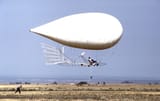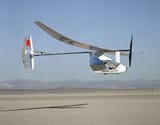>>2044147 #
I do not disagree with anything you:'ve said here.
Your observations support my notion: It is considered a challenge for a reason. From my POV OP makes an attempt to declare the challenge to be 'won' long ago in a sense that would make it obsolete now. It is not. It is still a valid engineering challenge and only that. For obvious reasons there will never be a practical application of the exact requirements of the 'human powered flight'-challenge. Most centrally: There is no need for the whole thing. There is no need to adhere to the standards put forth by the challenge in a 'practical' scenario. And then all the technical limitations.
I find one point you made very interesting: When is a craft 'heavier than air' by definition? I imagine if the crafts own weight was almost completely but not entirely offset by a buoyancy mechanism it should count as a heavier than air craft. If on the other hand the buoancy was such that it goes beyond and also offsets some of the pilots weight (implying it offsets more than all of the crafts weight making the craft in isolation lighter than air) it is not heavier than air.
Either way: The buoancy meme is not a real solution either because it will always imply a certain volume of the craft, which implies frontal area, which very quickly negates any human power input in a real world (windy) scenario.


